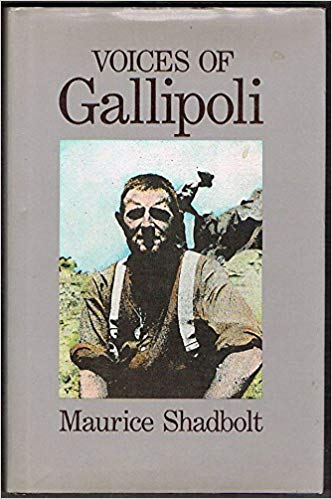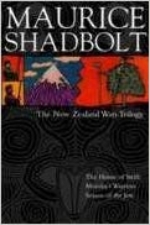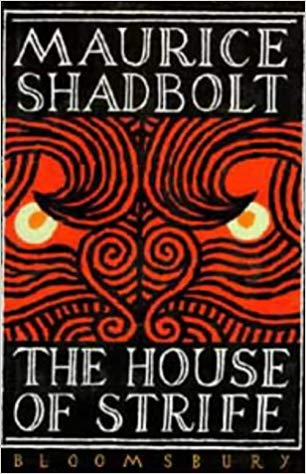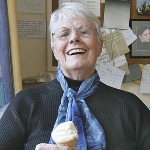Background
Maurice Francis Richard Shadbolt was born on the 4th of June, 1932 in Auckland, New Zealand.
1956
Don Oakley, Eric Lee-Johnson and Maurice Shadbolt
1956
Maurice Shadbolt filming a National Film Unit documentary about Opo, ‘the friendly dolphin’, at Opononi in 1956.
1957
Maurice Shadbolt at play with Jenny Bojilova at Bistritsa, Bulgaria, in October 1957.
1957
The Shadbolt family at Glen Eden, Auckland, January 1957, (from left) Vi, Julia, Frank, Maurice, Gill and Joe.
1958
Maurice Shadbolt (third from left) and his wife Gill (second from left) in a Campaign for Nuclear Disarmament March in London in 1958.
1959
Maurice Shadbolt
1960
Maurice in his a-frame study at the Marua, 1960.
1960
Brian Brake and Maurice on the road for national geographic, 1960.
1965
Maurice Shadbolt
1972
Shadbolt (left) aboard the yacht Tamure with (clockwise from back left) Jim Sharp, Jack Harker and Jim Cottier before setting sail for Mururoa in 1972.
1975
Maurice Shadbolt signing copies of his book Strangers and journeys for friends. Left to right: Annette Isbey, Eddie Isbey, Maurice, Karl Stead, Kay Stead, Keith Sinclair.
1986
Maurice Shadbolt
1989
Maurice Shadbolt
51 Victor Street, Avondale, Auckland 1026, New Zealand
Maurice Shadbolt attended Avondale College.
Auckland 1010, New Zealand
Maurice Shadbolt attended Auckland University College.














(A colorful and imaginative saga of pioneering New Zealand...)
A colorful and imaginative saga of pioneering New Zealand during the nineteenth century describes the unusual lives of the three Lovelock brothers, the courageous visionary Herman, wretched Richard, and poetic James.
https://www.amazon.com/gp/product/0312499531/?tag=2022091-20
1980

(Based on diary entries of New Zealand soldiers sent to fi...)
Based on diary entries of New Zealand soldiers sent to fight the long and futile battle of Gallipoli in 1915, during which nearly 3,000 of them died, this is an account of that tragic campaign, charting the suffering and disillusionment of those who arrived as innocent and loyal sons of the Empire.
https://www.amazon.com/Voices-Gallipoli-Maurice-Shadbolt/dp/0340431369/?tag=2022091-20
1988

(Based on fact, this tells of Kimball Bent, a Yankee who b...)
Based on fact, this tells of Kimball Bent, a Yankee who blundered into the British army in the mid-19th century and was sent to fight in New Zealand. He deserted across battle lines to the Maori side in possibly the most ferocious colonial war ever fought.
https://www.amazon.com/Mondays-Warriors-Maurice-Shadbolt/dp/0340549017/?tag=2022091-20
1990

(This is the third book in Shadbolt's "Maori Trilogy", and...)
This is the third book in Shadbolt's "Maori Trilogy", and is set in the 1840s when New Zealand was annexed by Queen Victoria. It combines historical detective work with humor and a host of eccentric characters.
https://www.amazon.com/House-Strife-Maurice-Shadbolt/dp/0747516162/?tag=2022091-20
1993
journalist playwright scriptwriter author
Maurice Francis Richard Shadbolt was born on the 4th of June, 1932 in Auckland, New Zealand.
As a child, Maurice Shadbolt studied at Te Kuiti High School. After that, he attended Avondale College and Auckland University College.
Maurice Shadbolt was capped an Honorary Doctor of Literature by the University of Auckland in 1997.
Maurice Francis Richard Shadbolt began his career as a journalist for various New Zealand publications in 1952-1954. He worked for a time for the Taranaki Daily News and as a director and scriptwriter of documentaries for the New Zealand National Film Unit from 1954 to 1957.
In 1957 Maurice Francis decided to become a full-time writer. He spent some peripatetic years traveling to such places as Australia, Russia, Bulgaria, and China, before moving to England, where he published his short-story collection "The New Zealanders" in 1959.
Moving back to his homeland, Shadbolt continued to write fiction while supplementing his income with nonfiction works, such as the co-written "New Zealand: Gift of the Sea" in 1963. With his first novel "Among the Cinders" that was written in 1965, Shadbolt began to build a reputation as an author of historical fiction that combined descriptions of stunning New Zealand scenery with a mix of reality and mythology.
Among his most notable books are "The Lovelock Version" that was published in 1980, and the trilogy of novels about the wars between natives and British colonizers, including "Season of the Jew" in 1987, "Monday's Warriors" in 1990, and "House of Strife" in 1993.
Toward the end of his life, Maurice Francis Richard Shadbolt completed three autobiographical works "One of Ben's: A New Zealand Medley" in 1993, "Dove on the Waters" in 1996, and "From the Edge of the Sky" in 1999.
Shadbolt is undoubtedly one of New Zealand's best known literary figures. During his career, he received numerous awards, among them are Hubert Church Prose Award, two Katherine Mansfield Awards, National Association of Independent Schools Award, Freda Buckland Award, Pacific Area Travel Association Award, three James Wattie Awards, New Zealand Book Award
Maurice Francis Richard Shadbolt received the New Zealand Scholarship in Letters in 1959, 1970 and in 1982. In 1963, he earned a University of Otago Robert Burns fellowship. Maurice Shadbolt was made a Commander of the Order of the British Empire, for services to literature in 1989.
(Based on diary entries of New Zealand soldiers sent to fi...)
1988(A colorful and imaginative saga of pioneering New Zealand...)
1980(Based on fact, this tells of Kimball Bent, a Yankee who b...)
1990(This is the third book in Shadbolt's "Maori Trilogy", and...)
1993Maurice Francis Richard Shadbolt was married four times. His first marriage was with Gillian Eve Muriel Heming. They were married for 15 years and had four children together, Sean, Brendan, and twins Tui and Daniel. In 1971 he married Barbara Magner. They had a daughter, Brigid. He also was married to Bridget Armstrong and Elspeth Sandys, but both marriages ended in divorce.
Gillian Eve Muriel Heming was an Australian journalist, author, and lecturer in journalism at Wellington Polytechnic 1970s-1980s.

Barbara was a pioneer of broadcasting in New Zealand. In her 20s Magner joined the New Zealand Broadcasting Corporation and worked on radio stations in Dunedin and Invercargill. After the NZBC opened a television station in Dunedin in 1962, she did four nights a week as a continuity announcer, then moved to Auckland to host an evening radio show on 1ZB.
Magner’s fame likely reached its high point when she joined the crew of reporters on the Auckland edition of five nights a week magazine show Town and Around in the 1960s. In the 70s, Magner read the news on TV One’s Tonight at Nine and reported for Arts Review. In 1977 she began working as an education officer for the Health Department.

Bridget Armstrong was born on the 15th of March, 1937 in Dunedin, New Zealand. She is an actress, known for BBC Play of the Month, Compact and BBC Sunday-Night Play.
Armstrong attended Otago University. At 18, Armstrong joined national touring company the New Zealand Players, founded by Richard Campion. Her first show with the company was Salad Days. She stayed with the Players for two years, recreating characters from Anne Frank to Elizabeth I. In 1959 she acted in a BBC adaptation of Bruce Mason’s The Pohutukawa Tree. Armstrong swiftly found success on stage and screen, exercising her comedic and dramatic muscles in TV roles including The Benny Hill Show, Crossroads, and Gloss style soap Compact. Later she appeared in Eric Idle's Monty Python followup Rutland Weekend Television, the same year (1975) that a role in a BBC version of the play The School for Scandal. Armstrong was also part of the dinner party ensemble in a well-reviewed 1979 movie of Roger Hall’s Middle Age Spread.

Elspeth Somerville Sandys is a New Zealand author. She was born in Timaru, New Zealand and educated at Otago and Auckland Universities. She has been a full-time writer for the last 35 years. In that time, she has published nine novels, two collections of short stories and two memoirs. Her fiction focuses on relationships: personal, social and political. Elspeth has written extensively for the BBC and RNZ, both original plays and adaptations, as well as a number of film and television scripts. Her stage plays have been performed in England and New Zealand. She has worked as a creative writing teacher, editor for Oxford University Press, and ghostwritten several non-fiction works including, A State of Blood and The Survival of Jan Little.
Among her writings are “Catch a Falling Star” in 1978, “The Burning Dawn” in 1981, “Love and War” in 1982 and others. Her most recent work “Obsession” came out in 2017”. Elspeth has received many awards and fellowships in recognition of her work, and in 2006 was made an Officer of the New Zealand Order of Merit for services to literature.
